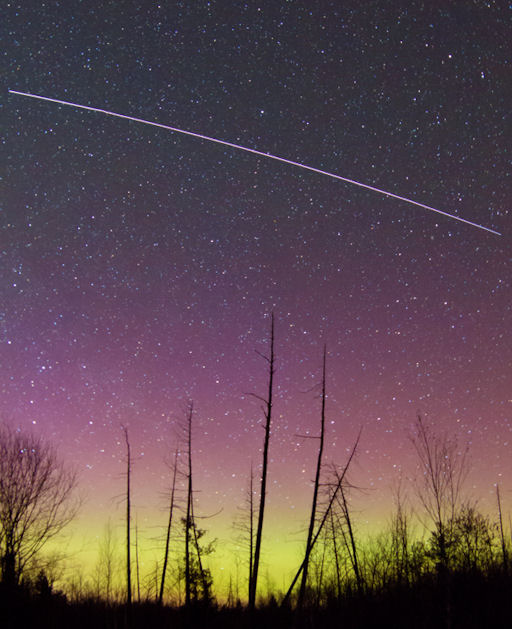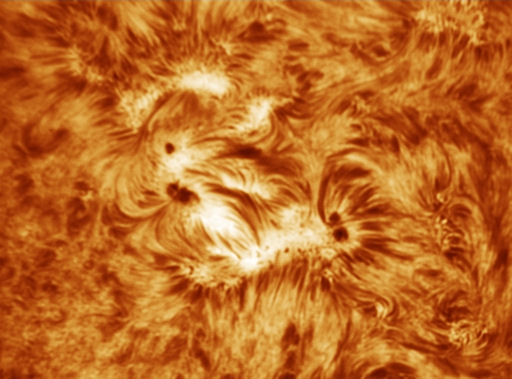LUCKY MAGNETIC STORM: A solar wind stream hit Earth's magnetic field on April 12th, sparking a geomagnetic storm (Kp=5) that peaked during the early hours of Friday the 13th. Northern Lights were sighted over the USA as far south as Minnesota, Michigan, and Wisconsin. In Beecher, Wisconsin, photographer Brian Larmay made this lucky shot of the International Space Station flying through the display:
"The auroras were very impressive here in northeastern Wisconsin," says Larmay.
Another photographer, Shawn Malone of Marquette, Michigan, sends this report from the shores of Lake Superior: "The sky was ablaze in light. Northern lights were so bright they lit up the beach! It was an amazing night."
NOAA forecasters estimate a 30% to 40% chance of more geomagnetic activity during the next 24 hours as the solar wind continues to blow. Aurora alerts: text, phone.
more images: from P-M Hedén of Tänndalen, Sweden; from Jónína Óskarsdóttir of Faskrudsfjordur, Iceland; from Nenne Åman of Arjeplog Lapland, Sweden; from Janis Satrovskis of Valmiera, Latvia; from LeRoy Zimmerman of Ester, Alaska; from Ben Beaucher of Wemindji, James Bay, Quebec; from Börkur Hrólfsson of Holtavörðuheiði, Iceland; from Ronan Newman of Charlestown, County Mayo, Ireland; from Göran Strand of Östersund, Sweden; from Paul Martin of Omagh, N. Ireland; from Stine Vibeke Bratteberg of Ørsta, Møre og Romsdal, Norway;
GROWING SUNSPOT: Almost directly facing Earth, sunspot AR1455 is growing rapidly. "This active region is becoming more interesting by the day and forms a nice group of sunspots now," says amateur astronomer Dennis Put who send this snapshot from Brielle, the Netherlands:
The picture, which he took using an H-alpha telescope tuned to the red glow of solar hydrogen, captures the maelstrom of hot plasma and magnetism swirling atop the sunspot group's underlying dark cores. If the region continues to grow it could soon become a source of C-class solar flares.

![]()
Solar wind
speed: 579.4 km/sec
density: 0.0 protons/cm3
explanation | more data
Updated: Today at 1616 UT
![]()
X-ray Solar Flares
6-hr max: B3 1438 UT Apr13
24-hr: B5 0507 UT Apr13
explanation | more data
Updated: Today at: 1600 UT
![]()
![]()
![]()
Daily Sun: 13 Apr 12
![]()
![]()
Sunspot 1455 is growing and could soon pose a threat for C-class solar flares. Credit: SDO/HMI
![]()
![]()
![]()
Sunspot number: 50
What is the sunspot number?
Updated 12 Apr 2012
Spotless Days
Current Stretch: 0 days
2012 total: 0 days (0%)
2011 total: 2 days (<1%)
2010 total: 51 days (14%)
2009 total: 260 days (71%)
Since 2004: 821 days
Typical Solar Min: 486 days
Updated 12 Apr 2012
The Radio Sun
10.7 cm flux: 95 sfu
explanation | more data
Updated 12 Apr 2012
![]()
![]()
![]()
Current Auroral Oval:
![]()
Switch to: Europe, USA, New Zealand, Antarctica
Credit: NOAA/POES
![]()
![]()
![]()
Planetary K-index
Now: Kp= 2 quiet
24-hr max: Kp= 5 storm
explanation | more data
![]()
Interplanetary Mag. Field
Btotal: 3.5 nT
Bz: 0.6 nT north
explanation | more data
Updated: Today at 1616 UT
![]()
![]()
![]()
Coronal Holes: 13 Apr 12
![]()
![]()
Earth is inside a solar wind stream flowing from this coronal hole. Credit: SDO/AIA.






